- Protocol affairs

Ceremony of Presentation of the Letters of Credence
- Deputy Ministers
- Secretary General
- Permanent representations
- Procedure for obtaining of Identification cards
- Registration and removal of the vehicle from the register
- The Procedure for obtaining of Driving License
- Procedure on the provision of escorted visitor passes to the restricted zones of airport
- Applicable documents
- FAQ about refund of VAT
- International Organizations
The Ceremony of Presentation of the Letters of Credence takes place in the central "Round" Hall of the Presidential Palace. The Ambassador departs for the Presidential Palace from the Ministry of Foreign Affairs (residence, hotel) fifteen-twenty minutes before the beginning of the ceremony (transport provided by MFA). He/she is accompanied by his/her spouse, Chief of the State Protocol, Director of the regional department of the Foreign Ministry, as well as the Embassy staff members (2-3 persons). At the main entrance of the Presidential Palace the Ambassador is met by the protocol officer and accompanied to the “Round” Hall. The Ambassador and accompanying persons enter the Hall, take up their places /see the scheme/ and wait for the President.
Disposition is the following: First row: Ambassador, Chief of State Protocol (on the right), Director of the regional department of the Foreign Ministry (on the left) Second row: Spouse of the Ambassador Third row: Protocol officers and Embassy staff members
The President enters the Hall. He is accompanied by the Minister (Deputy Minister) of Foreign Affairs (on the right), the interpreter (on the left), Chief of External Relations Department of the Administration of the President, Chief of Public Relations Department, Press Secretary of the President and Chief of Protocol Desk. The Ambassador greets the President by slightly nodding him, to which the President replies with a similar gesture. The Chief of State Protocol introduces the Ambassador to the President. Afterwards, the Ambassador makes a short greeting speech (max. 2 minute). Then he/she approaches the President, hand him over the Letters of Credence and the Letters of Recall of his/her predecessor, shakes hands with the President and without turning returns to his/her initial place.
On his turn the President greets the Ambassador, after which they approach the centre of the hall for a photograph. Afterwards, the Chief of State Protocol invites the Ambassador to introduce his/her spouse and the Embassy staff members to the President. A 20-25 minutes courtesy meeting with the President takes place at the “Green” Hall of the Presidential Palace. Senior diplomats of the Embassy may participate at the meeting.
After the meeting the Ambassador and accompanying persons depart for the Embassy (residence, hotel)
Dress code: Dark suit or national dress /if in use/.
Credentials Page URL copied to clipboard!
The name for letters given to an ambassador by their chief of state, and addressed to the chief of state of the host country. Credentials are delivered to the chief of state by the ambassador in a formal credentials ceremony, which generally takes place shortly after the ambassador’s arrival at a new post. Until this ceremony has taken place, the ambassador is not formally recognized by the host country and cannot officially act as an ambassador. The letters are termed “letters of credence” because they request the receiving chief of state to give “full credence” to what the ambassador will say on behalf of their government.
Ceremony and background
The presentation of letters of credence is a custom dating from the late Middle Ages. Newly appointed foreign ambassadors are received by the King at Noordeinde Palace shortly after their arrival in the Netherlands. A ceremonial reception of this kind emphasises that the Netherlands highly values and respects relations with the country in question.
A state coach, drawn by two horses, collects the ambassador-designate from his or her residence in The Hague or from a hotel if he/she is resident in another country. A guard of honour and a military band are drawn up in the forecourt of Noordeinde Palace. The band plays four drum rolls, followed by the ambassador’s national anthem, after which the ambassador inspects the guard of honour. Inside the palace, the presentation of the ambassador’s letters of credence is followed by a short talk with the King.
Ambassadors are officially accredited from the moment that the King accepts their credentials. 170 ambassadors are accredited to the Netherlands. Dutch ambassadors, too, present letters of credence signed by the King to the head of state of the country to which they are accredited.
Departing foreign ambassadors who have been in post in the Netherlands for more than three years are again received by the King in audience.
Share this page
- Share this page on your Twitter account
- Share this page on your Facebook account
- Share this page on your LinkedIn account
ADDRESS OF POPE FRANCIS ON THE OCCASION OF THE PRESENTATION OF LETTERS OF CREDENCE OF THE AMBASSADORS OF SWITZERLAND, LIBERIA, ETHIOPIA, SUDAN, JAMAICA, SOUTH AFRICA AND INDIA TO THE HOLY SEE
Clementine Hall Thursday, 15 May 2014
Your Excellencies,
I am pleased to welcome you on the occasion of the presentation of the Letters accrediting you as Extraordinary and Plenipotentiary Ambassadors of your respective Countries to the Holy See: Switzerland, Liberia, Ethiopia, Sudan, Jamaica, South Africa and India. I am grateful to you for the readiness with which you take on this mission and I ask you to convey the expression of my gratitude and respect to the Heads of State of your respective Countries. I assure them and each one of you of my prayer, and for the Nations to which you belong I invoke from God Almighty an abundance of prosperity and peace.
Peace. This word sums up every good to which every person and every human society aspires. Indeed, in the final analysis, the commitment with which we seek to foster diplomatic relations has no other scope than this: to foster the growth of peace in justice and development throughout the human family. This end has never been fully reached, it asks to be sought again and again by every generation, confronting the challenges that every epoch poses.
Looking at the challenges that in this time of ours need to be urgently faced in order to build a more peaceful world, I would like to lay emphasis on two things: the arms trade and forced migration.
Everyone speaks of peace, everyone claims to desire it, but unfortunately the proliferation of arms of every kind leads to the opposite. The arms trade has the effect of complicating and hindering conflict resolution, the more so because it develops and works largely outside the law.
I maintain, therefore, that, while we are gathered in this Apostolic See, which by its nature is invested in a special way with serving the cause of peace, we can unite our voices in the hope that the international community will promote a new season of concerted and courageous commitment to prevent the growth of armaments and more especially for their reduction.
Another challenge to peace is right before our eyes, and unfortunately in certain regions and at certain times takes on the character of a very real human tragedy: forced migration. This phenomenon is very complex and we must, of course, acknowledge the noteworthy efforts undertaken by international organizations, States, social powers, as well as religious communities and volunteers that all strive to respond in a civil and organized way to the most critical aspects like: emergencies and the most dire situations. But, here too, we realize that we cannot limit ourselves to helping in emergencies. The phenomenon has already manifested itself in all its breadth and, so to speak, historic character. The time has come to face it politically in a serious, responsible way, involving all levels: global, continental, the macro-regions, relations between States, down to the national and local level.
In this area we see opposite experiences. On the one hand, amazing stories of humanity, encounter and welcome: individuals and families who manage to leave an inhumane situation and rediscover their dignity, freedom and security. On the other, unfortunately, there are stories that would make us weep and feel ashamed: human beings, our brothers and sisters, children of God who, urged by their desire to live and work in peace, face grueling journeys and are subjected to blackmail, torture, harassment of all kinds, to end up in some cases dying in a desert or at the bottom of the sea.
The phenomenon of forced migration is closely tied to conflict and war, and therefore also to the proliferation of weapons, which we spoke about earlier. These are the wounds of a world, which is our world, in which God placed us to live today and calls us to take responsibility for our brothers and for our sisters, that no human being may be violated in his dignity. It would be an absurd contradiction to speak of peace, to negotiate peace and, at the same time, promote or permit the arms trade. We can also think that it would be an attitude of cynicism to proclaim human rights and, simultaneously fail to take responsibility for the men and women who, forced to leave their homeland, die in the attempt or are not accepted by international solidarity.
Your Excellencies, the Holy See declares today to you and to the Governments of your respective countries its firm will to continue to cooperate to ensure that steps forward may be taken on these fronts and on all the roads that lead to justice and peace, on the basis of recognized universal human rights.
At this moment in which you begin your mission, I address my most heartfelt best wishes to you, assuring you of the Roman Curia’s cooperation in the fulfillment of your office. And as I express again my gratitude to you, I gladly invoke upon you, your colleagues and your families an abundance of divine blessings. Thank you.
Copyright © Dicastero per la Comunicazione - Libreria Editrice Vaticana
We’re sorry, this site is currently experiencing technical difficulties. Please try again in a few moments. Exception: request blocked

The Governor General of Canada
Her excellency the right honourable mary simon, presentation of letters of credence, june 7, 2022.
Her Excellency the Right Honourable Mary Simon, Governor General of Canada, welcomed seven new heads of mission to Canada during a ceremony at Rideau Hall.
The following new heads of mission presented their credentials:
His Excellency Hector Igarza Cabrera Ambassador of the Republic of Cuba
Her Excellency Yuliia Kovaliv Ambassador of Ukraine
His Excellency Carlos Alberto Patricio Játiva Naranjo Ambassador of the Republic of Ecuador
His Excellency António Manuel Torres Domingues Leão Rocha Ambassador of the Portuguese Republic
His Excellency Witold Mirosław Dzielski Ambassador of the Republic of Poland
His Excellency Kanji Yamanouchi Ambassador of Japan
His Excellency Zaheer Aslam Janjua Ambassador of the Islamic Republic of Pakistan
Upon their arrival in Canada, new heads of mission must present their letters of credence to the governor general before they can carry out their duties. Letters of credence are the official documents that accredit a diplomat as an ambassador or high commissioner to another country.
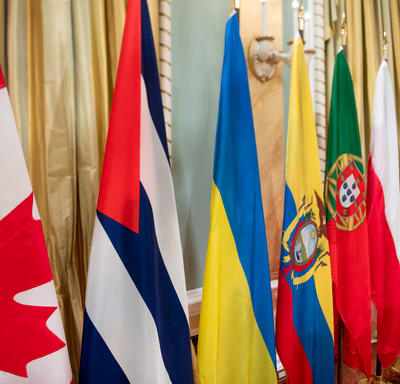
Upon their arrival in Canada, new heads of mission must present their letters of credence to the governor general before they can carry out their duties.
- Credit: MCpl Anis Assari, Rideau Hall
- Reference Number: GG08-2022-0147-003
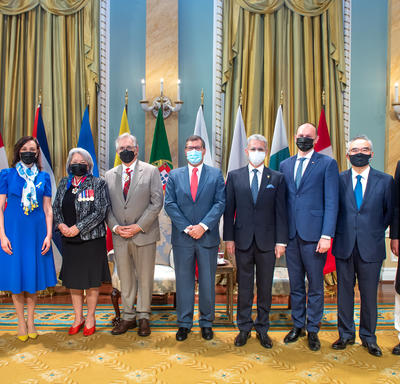
Her Excellency the Right Honourable Mary Simon, Governor General of Canada, welcomed seven new heads of mission to Canada during a ceremony at Rideau Hall.
- Reference Number: GG08-2022-0147-004
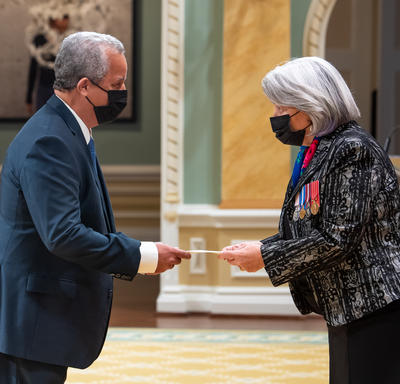
His Excellency Hector Igarza Cabrera, Ambassador of the Republic of Cuba, presented his letter to Her Excellency.
- Reference Number: GG08-2022-0147-012

- Reference Number: GG08-2022-0147-013

Her Excellency Yuliia Kovaliv, Ambassador of Ukraine, presented her letter to Her Excellency.
- Reference Number: GG08-2022-0147-015
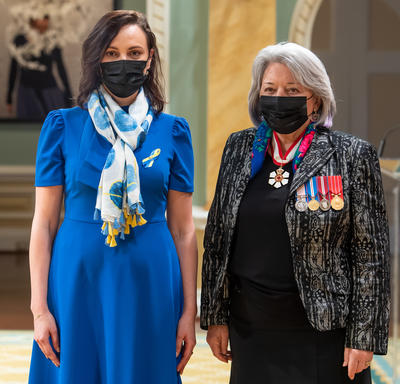
- Reference Number: GG08-2022-0147-016
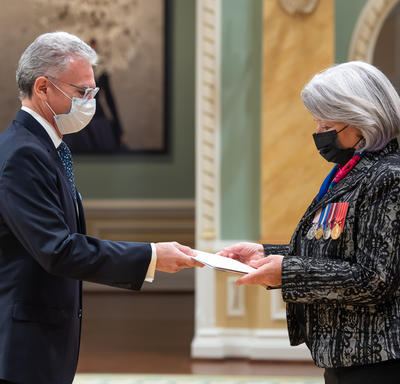
His Excellency Carlos Alberto Patricio Játiva Naranjo, Ambassador of the Republic of Ecuador, presented his letter to Her Excellency.
- Reference Number: GG08-2022-0147-018

- Reference Number: GG08-2022-0147-019
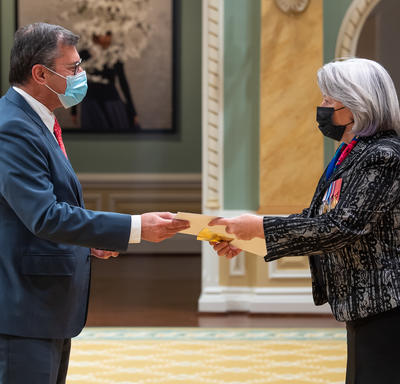
His Excellency António Manuel Torres Domingues Leão Rocha, Ambassador of the Portuguese Republic, presented his letter to Her Excellency.
- Reference Number: GG08-2022-0147-021
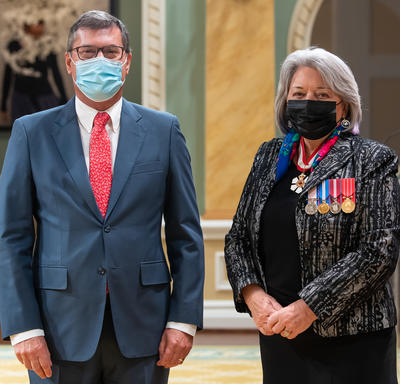
- Reference Number: GG08-2022-0147-022
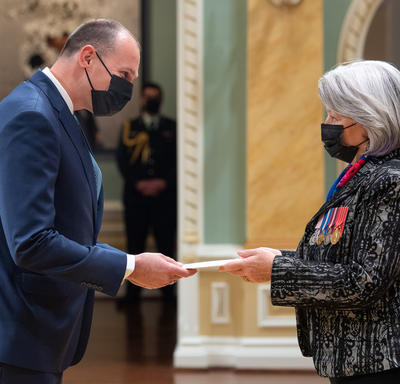
His Excellency Witold Mirosław Dzielski, Ambassador of the Republic of Poland, presented his letter to Her Excellency.
- Reference Number: GG08-2022-0147-024
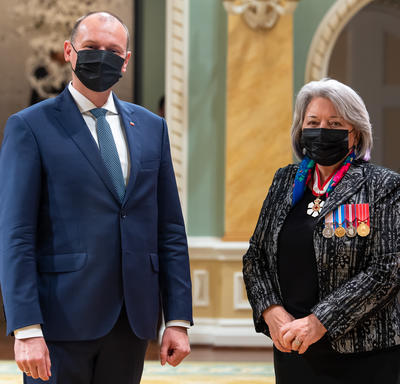
- Reference Number: GG08-2022-0147-025
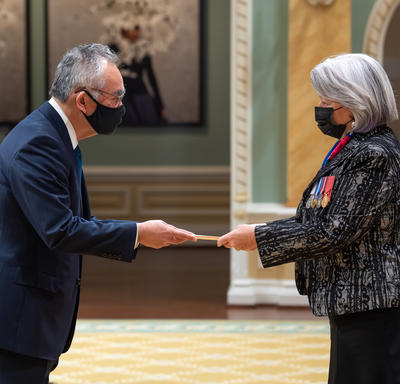
His Excellency Kanji Yamanouchi, Ambassador of Japan, presented his letter to Her Excellency.
- Reference Number: GG08-2022-0147-027
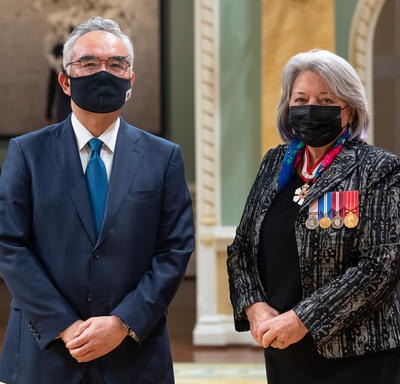
- Reference Number: GG08-2022-0147-030
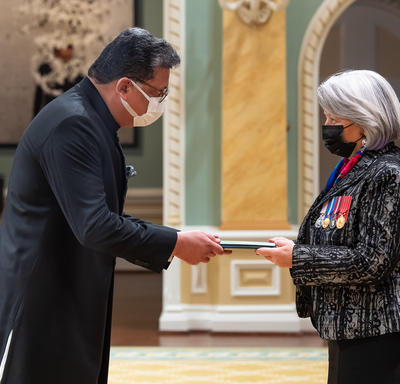
His Excellency Zaheer Aslam Janjua, Ambassador of the Islamic Republic of Pakistan, presented his letter to Her Excellency.
- Reference Number: GG08-2022-0147-032
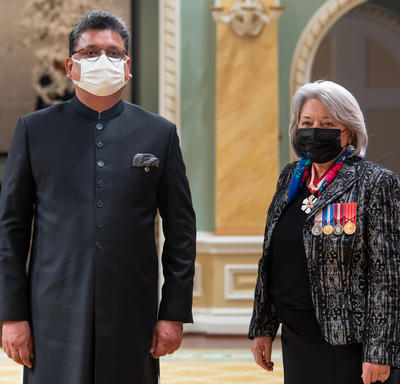
- Reference Number: GG08-2022-0147-033
Related Content
- Media Advisory — Governor General to welcome new heads of mission to Canada
- Speech — Letters of Credence Ceremony
- Photos — Presentation of Letters of Credence
- Information — Represent Canada
Protocol and NGO Liaison Office

Presentation of credentials - guidelines
The letter of credentials.
The letter of credentials of permanent representatives to the United Nations Office at Vienna are issued either by the Head of State or Government or by the Minister for Foreign Affairs of the sending country and are addressed to the Secretary-General of the United Nations by name and presented to the Director General of UNOV/ Executive Director of UNODC, who represents the Secretary-General and receives credentials on his or her behalf. Separate credentials should not be issued for the funds and programs and subsidiary entities affiliated with the United Nations Office at Vienna.
For a standard form of letters of credentials, please consult the example given.
Download | Standard letter of credentials
The presentation of credentials
When a new permanent representative assumes office, the mission should request the UNOV Protocol Service to make arrangements for the presentation of credentials.
Once a time and date for the presentation of credentials has been arranged, the Chief of Protocol welcomes the newly appointed permanent representative to the Vienna International Centre Rotunda (C-building). The permanent representative will then be escorted to the office of the Director-General/ Executive-Director by the Chief of Protocol and a courtesy Security Officer. The permanent representative may be accompanied by one or two members of his or her delegation as well as an interpreter provided by the mission, if necessary.
The presentation of credentials usually takes place in the office of the Director-General/ Executive Director. During the presentation, photographs of the Director-General/ Executive Director with the newly appointed permanent representative are taken by a photographer. Electronic copies of the photographs will be sent to the mission concerned.Then, less formally, the Director-General/ Executive-Director briefs the new permanent representative on present and forthcoming activities of the organisation with the represented country.
According to established practice, the meeting will usually not take longer than 30 minutes. Permanent representatives are not expected to make formal speeches during the presentation ceremony.
- Fraud Alert
- Legal Notice
- Culture, Language & Education
- Higher Education, Research & Innovation
- Consulate in Edinburgh
- Consulate in London
French Embassy in London
Home > The Ambassador > Ambassador Hélène Duchêne > Ambassador presents credentials to HM The King
- Réduire la police du site
- Agrandir la police du site

Ambassador presents credentials to HM The King
Hélène Duchêne, French Ambassador to the United Kingdom, presents her letters of credence to King Charles III at Buckingham Palace

The French Ambassador to the United Kingdom, Mme Hélène Duchêne, presented her letters of credence to King Charles III at Buckingham Palace on 9 February 2023.
In the UK, letters of credence are presented at a formal ceremony during which the King has audiences with the heads of diplomatic missions. Hélène Duchêne is the first French ambassador to present her letters of credence to King Charles III. She took up her post in London on 1 November 2022.

The Ambassador reiterated to the King the French President’s friendship and his wish “to maintain and strengthen relations between our two countries”.
View our photo coverage by clicking the image below

Published on 04/04/2023
Also in this section
Quick access.
- Consulate generals of France in the UK
University letters of recommendation: an essential guide
Letters of recommendation can make or break a student’s university application, so it’s important that we get them right

Phillip Wenturine

You may also like

There are a plethora of documents that go into compiling the perfect college application. From transcripts to predicted grades, activity lists, resumés or CVs, essays, recommendation letters, certificates and more – each element of the application holds a different purpose and separate weight of importance, often varying from country to country and university to university.
By the senior year (Year 13), academics are nearly finalised, so there’s little wiggle room when it comes to improving that element of the application: senior GPA is set and calculated; IB predictions are nearly issued.
But beyond academics, some universities require recommendation letters, and this is where a student can stand out more, highlighting and emphasising their skills, qualities and abilities.
These recommendation letters can sometimes illuminate the true heart and soul of the student, beyond their transcripts or personal-statement essay. The words in these letters can make or break a student’s application, so it’s important we get them right and tell their story with the thought and effort it deserves.
Teacher letters of recommendation
In a teacher’s recommendation letter, students are brought to life beyond their grades, showcasing their holistic potential.
Teachers seize the chance to praise consistent academic excellence, to spotlight specific projects or skills, and to contextualise grade fluctuations resulting from personal circumstances.
These letters illustrate growth, revealing students’ readiness for university life. The emphasis is on articulating acquired skills and potential – a narrative far more impactful than grades alone. While an A-grade student may excel in tests, a B-grade student might exhibit invaluable traits, such as grit and resilience, best articulated through personalised advocacy.
Recommendation letter timelines
To support students and teachers, it’s important to highlight the importance of the teacher recommendation letter early on to teachers and students alike. Let students know as early as grades 10 and 11 (Years 11 and 12) that it’s important to build relationships with teachers well in advance of senior year. The best letters come from those teachers who have an excellent rapport with the student in question.
Ask students in the spring of junior year (Year 12) to select those teachers they would like recommendation letters from. The recommendation should ideally come from a core-subject teacher (maths, science, social studies, English) rather than an elective teacher, unless the elective is a field in which they intend to pursue a career.
To support the teachers, we work with students to compile what we call a brag sheet. Students answer a series of questions about themselves, in order to give the teacher the best context for writing the letter.
We tell teachers that if the student does not provide this brag sheet, or if they feel that the student has not performed well enough in their class to deserve a letter, they are allowed to respectfully decline the request to write the letter.
We also remind teachers that they do not need to agree to write any more than 20 letters. It is unfair if students all ask one teacher – who may then end up writing 60 letters – for a recommendation letter, while other teachers only have to write a few.. With that in mind, we also remind students of the importance of being organised and requesting the letter from their preferred teacher early on.
Writing the letters
Here are some examples of the questions we ask students on their brag sheets, which then give teachers a starting point for their letters:
- What do you hope this letter will show about you that your GPA doesn’t?
- What was a challenge that you faced in this class, and what actions did you take to overcome it?
- Describe how this class influenced you, either through academic content or teacher interaction.
- Give between one and three examples of times when you have exceeded expectations with your communication skills, and also some areas where you can reflect that you may need growth.
- What majors or careers interest you?
To support the teachers further, we host a writing workshop in the spring of each year to give them examples of strong and weak letters (all confidential). We coach them in "show, don't tell" when it comes to writing about students’ strengths, as well as giving them concrete examples of how best to advocate for students and highlight their strengths.
We review what each different country’s universities desire from these letters, as some universities – such as the US – appreciate a holistic view of the student (for example, highlighting student athletes or detailing extracurriculars). By contrast, the UK is very academic-focused and prefers to read about the student’s abilities when working on class projects, research and outside endeavours in the field of study.
Counsellor recommendation letters
Some universities – mostly in the US – also allow a counsellor letter of recommendation. This letter goes beyond academic ability in the classroom and speaks more to students’ characteristics, personality, outside involvement and external factors helpful for an admission committee to review in the context of other application documents.
The counsellor’s role is to fill in the missing pieces of an application: we help identify and tell a student’s story, covering any hardships, exceptional leadership abilities, impressive commitment to community and so on.
Now more than ever, admission committees are telling us that they trust the counsellor and teacher letters to help give them the full picture of a student, and to help them judge whether or not they will be the best fit for their incoming class and able to thrive on their campus.
We send our students what we call a junior questionnaire, in order to collect the information necessary to write these letters successfully.
Some examples of the questions on the junior questionnaire:
- What languages do you speak, and to what level of fluency?
- Please provide some details about your family and highlight any diversity and/or adversity that you have experienced.
- Have there been any major circumstances that have impacted on your personal or academic life?
- What are three adjectives you would use to describe yourself? Think deeply about this one.
- How have you used your time outside of school, and can you elaborate on any particular projects, clubs, work experience, internships, or volunteer work that speaks to consistency in an activity, leadership experience or a particular commitment to have an impact on your community?
External letters
Sometimes students may wish to have an outside recommendation letter from a coach – for example, if they are a student athlete.
Overall, references should be academic-focused, but some universities that accept more than one letter are willing to receive one from an outside observer, too. In these cases, the person should be someone who oversees the student as the coach of a sport or the supervisor of an internship or work-experience programme.
The external referee should give this letter to the counsellor to send off on their behalf, as all recommendation letters must confidential and never shared with the student.

IMAGES
COMMENTS
Letter of credence for the Czechoslovak Ambassador to Lithuania (1992), written in the traditional French and signed by President Václav Havel. A letter of credence (French: Lettre de créance) is a formal diplomatic letter that designates a diplomat as ambassador to another sovereign state. Commonly known as diplomatic credentials, the letter is addressed from one head of state to another ...
The Ceremony of Presentation of the Letters of Credence takes place in the central "Round" Hall of the Presidential Palace. The Ambassador departs for the Presidential Palace from the Ministry of Foreign Affairs (residence, hotel) fifteen-twenty minutes before the beginning of the ceremony (transport provided by MFA). He/she is accompanied by his/her spouse, Chief of the State Protocol, Director o
The letters are termed "letters of credence" because they request the receiving chief of state to give "full credence" to what the ambassador will say on behalf of their government. Donate to the Collections Do you have an item that you feel would be at home in our collections? The National Museum of American Diplomacy is always looking ...
Presentation of the Letters of Credence by the Ambassadors of Sweden, Fiji, Moldova, Mauritius, ... I am pleased to receive you for presentation of the Letters accrediting you as Ambassadors Extraordinary and Plenipotentiary to the Holy See on the part of your respective countries: Burundi, Fiji, Mauritius, Moldova, Sweden and Tunisia. ...
PRESENTATION OF LETTERS OF CREDENCE BY THE AMBASSADORS OF MOLDOVA, KYRGYZSTAN, NAMIBIA, LESOTHO, LUXEMBOURG, CHAD AND GUINEA-BISSAU. ADDRESS OF HIS HOLINESS POPE FRANCIS. Clementine Hall Friday, 17 December 2021 _____ Your Excellencies, I am pleased to receive you for the presentation of the Letters accrediting you as Ambassadors Extraordinary ...
About Press Copyright Contact us Creators Advertise Developers Terms Privacy Policy & Safety How YouTube works Test new features NFL Sunday Ticket Press Copyright ...
Other articles where letter of credence is discussed: diplomacy: Credentials: …is sent forth with a letter of credence addressed by his head of state to the head of the host state to introduce the ambassador as his or her representative. In most major capitals a copy of credentials is now first provided privately to the foreign minister, after which the…
The presentation of letters of credence is a custom dating from the late Middle Ages. Newly appointed foreign ambassadors are received by the King at Noordeinde Palace shortly after their arrival in the Netherlands. A ceremonial reception of this kind emphasises that the Netherlands highly values and respects relations with the country in question.
The ceremony was held in the St Alexander Hall of the Grand Kremlin Palace. September 20, 2022. 12:40. The Kremlin, Moscow. 5 of 8. Ceremony for presenting letters of credence. Photo: Pavel Bednyakov, RIA Novosti. The President of Russia received the letters of credence from Daniel Ruben Castillos Gomez (Oriental Republic of Uruguay), Smail ...
December 2, 2021. Her Excellency the Right Honourable Mary Simon, Governor General of Canada, welcomed four new heads of mission to Canada during a formal presentation ceremony at Rideau Hall. Upon their arrival in Canada, new heads of mission must present their letters of credence to the governor general before they can carry out their duties.
ON THE OCCASION OF THE PRESENTATION OF THE LETTERS OF CREDENCE. Clementine Hall Thursday, 12 December 2013 . Your Excellencies, I am pleased to welcome you on the occasion of the presentation of the Letters accrediting you as Ambassadors Extraordinary and Plenipotentiary to the Holy See on the part of your respective countries: Algeria, Iceland ...
Vladimir Putin received letters of credence from 20 newly arrived foreign ambassadors. As is traditional, the ceremony took place in the Alexander Hall of th...
The ceremony of presentation of Credentials of Ambassador of Ecuador, Jaime Marchán-Romero, to Her Majesty Queen Elizabeth. His Excellency Mr. Jaime Marchán ...
Letters of credence are the official documents that accredit a diplomat as an ambassador or high commissioner to another country. As an act of solidarity with the Ukrainian people, Governor General Mary Simon wore her kokum scarf during this morning's virtual presentation of letters of credence.
Speech at Presentation of Foreign Ambassadors' Letters of Credence. December 16, 2009. 12:48. The Kremlin, Moscow. President of Russia Dmitry Medvedev: Ladies and gentlemen, Today's presentation of letters of credence opens a new chapter in your diplomatic work. I sincerely wish you success and hope that Russia's bilateral relations with ...
The ceremony was held in the Grand Kremlin Palace's Alexander Hall. May 18, 2021. 11:25. The Kremlin, Moscow. 1 of 8. During the presentation of foreign ambassadors' letters of credence. Letters of credence were presented to the President of Russia by Zeljko Samardzija (Bosnia and Herzegovina), Khaled Shawabkeh (Hashemite Kingdom of Jordan ...
Your Majesty, King Letsie III, It is a great privilege and honour for me to present to Your Majesty the Letter of Credence by which His Excellency Michael D Higgins, President of Ireland, appoints me Ambassador Extraordinary and Plenipotentiary of Ireland to the Kingdom of Lesotho, along with the Letters of Recall of my predecessor, Ambassador ...
on the occasion of the presentation of letters of credence of the ambassadors of switzerland, liberia, ethiopia, sudan, jamaica, south africa and india to the holy see. clementine hall thursday, 15 may 2014. your excellencies,
February 12, 2015 (13:00) Vila Vodno, Skopje. (As drafted) President Ivanov, it is a pleasure to meet you and to offer you my letter of credence. Thank you for hosting this ceremony. I am honored to represent President Obama and the American people as the United States' Ambassador to the Republic of Macedonia. Our countries have much in common.
Standard letter of credentials - United Nations Office at Vienna Head of State, or Head of Government, or Minister for Foreign Affairs [Date] Excellency, I have the honour to inform Your Excellency that [the Government of _____] [we (name and title)], has [have] appointed and by these presents do confirm as Permanent
Upon their arrival in Canada, new heads of mission must present their letters of credence to the governor general before they can carry out their duties. Letters of credence are the official documents that accredit a diplomat as an ambassador or high commissioner to another country. Her Excellency the Right Honourable Mary Simon, Governor ...
The letter of credentials. The letter of credentials of permanent representatives to the United Nations Office at Vienna are issued either by the Head of State or Government or by the Minister for Foreign Affairs of the sending country and are addressed to the Secretary-General of the United Nations by name and presented to the Director General of UNOV/ Executive Director of UNODC, who ...
The French Ambassador to the United Kingdom, Mme Hélène Duchêne, presented her letters of credence to King Charles III at Buckingham Palace on 9 February 2023. In the UK, letters of credence are presented at a formal ceremony during which the King has audiences with the heads of diplomatic missions. Hélène Duchêne is the first French ...
Recommendation letter timelines. To support students and teachers, it's important to highlight the importance of the teacher recommendation letter early on to teachers and students alike. Let students know as early as grades 10 and 11 (Years 11 and 12) that it's important to build relationships with teachers well in advance of senior year.